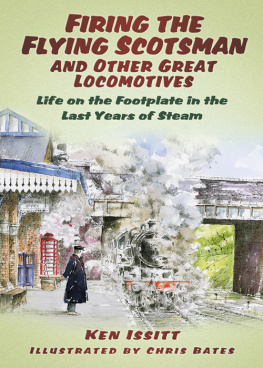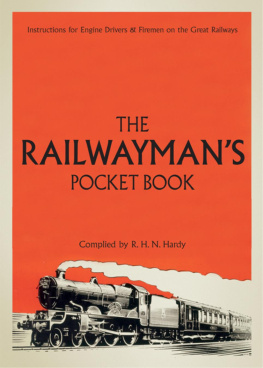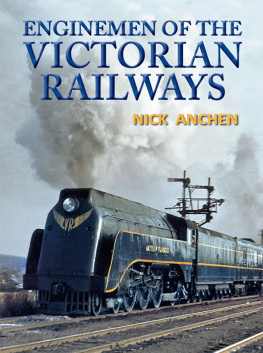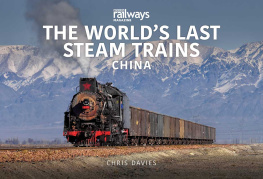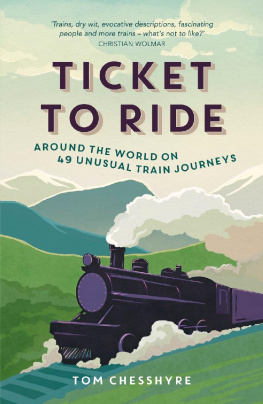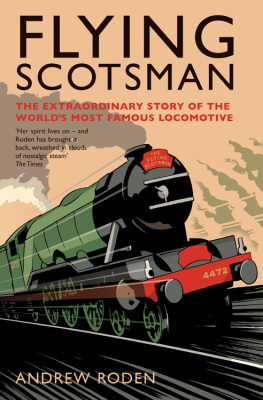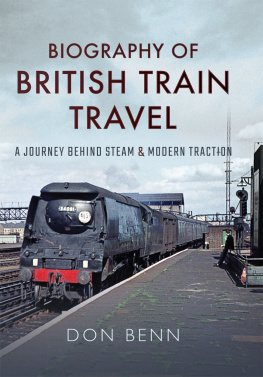For Alice Starmore
1886 1985
CONTENTS
W hen I sat down to write my thank yous I thought it would be an easy job. It turned out to be a thought-provoking exercise. I do not intend to list my thanks but rather to offer my thoughts.
When I started to write this book, illustrating had not occurred to me. It was only when I was telling Chris, who plays sax alongside me in a swing band, what I was doing and he said that he was an artist that it suddenly dawned on me that I could ask him to illustrate the book. And that is what he has done.
Chris did not know about footplate life with all that it entailed. I told him about some of the things that happened to me during my time on the footplate and since then he has made it his business to become familiar with steam locomotives, visiting the Midland Mainline Steam Trust, asking questions and taking photographs so that he could get the feel as much as possible of bygone railway days. Chris has drawn his sketches in the genre of the fifties, the time in which my stories are set. My thanks go to Chris.
Between us at times in the vernacular and at times in the traditions of storytellers we have tried to bring the stories to life.
So many people are enthused by the steam locomotive. The romance of trains steaming through the countryside seems to be in our collective memory. There is, too, a resurgence of interest. Booksellers have magazines on their shelves; even garden centres have books about steam trains. This can be seen in the request for stories about the Flying Scotsman, the writing about which inspired me to write about other things that happened to me in the 1950s. So in saying thank you I realise that my contribution to this scene was to write about my time on the railway in which I was actively involved. My thanks are to all the people who from my recollections and subsequent connections have helped to rekindle my interest in steam locomotives. The response that Chris and I have had from the talks we have given has always been warm. Trips on the private railways and the volunteers who give their time, the popularity of York Railway Museum, and the building of the new steam locomotive Tornado all play a part in contributing to the scene into which my stories are set.

I had received a pamphlet from Eric Maxwell Bryce, a railway employee and lifelong railway enthusiast. Included in the pamphlet was a request for stories about the Flying Scotsman from York Museum. As I had earned my living on the footplate of that engine from time to time I was prompted to reply, so I am grateful to Max.
My thanks also go to Professor Rob Coles of the University of Leicester for his helpful and constructive comments.
My overwhelming gratitude goes to my sons Stephen, John and Michael. As a young boy Stephen knew more about the comings and goings of railway engines than I ever did, as he was an avid trainspotter.
My thanks also go to an ex-colleague, Ron Hefford; to Chriss Sue, who posed for many of the action drawings for Chris; to the late Gerald Boden, who kindly allowed Chris to climb over his LNER B1 steam engine Mayflower to take photographs; and thanks go to Jean Bryce, who patiently dotted the is and crossed the ts. Specially, I would like to thank Margaret, my wife, whose comments such as You cant write that; it doesnt make sense! made me realise that my feeble attempts to join the army of writers needed a bit more than just checking out in the dictionary to see whether a word had been spelt correctly. Margaret has been my driving force in all this. She has helped me understand that what I have done has been worthwhile. I couldnt have done it without her.
So my thank you is to all the people who have contributed in any way thank you!
Acknowledgements
What Do You Want to Be When You Grow Up?
On a Normal Shift Leicester to London and Return
The Flying Scotsman
The Night the Fire Went Out
Jigsaws
I Bet that Bloody Guards Asleep!
Put the Kettle On and Shout up the Stairs!
Line of Promotion
Extra-curricular
Fog in the Fifties
Backstage
Another Right Mess
Attempted Murder?
Eggs and Bluelegs
End Note
I Remember as if it was Yesterday
1
WHAT DO YOU WANT TO
BE WHEN YOU GROW UP?
Y ou tell a good tale, dont you? someone said to me recently. This brought me up with a start. I was telling a lady a story about my railway years that was perfectly true, with all sincerity. She clearly did not believe me. It made me recall a previous incident in which I had related the story Put the Kettle On and Shout up the Stairs! (chapter 7) to some young people I had met in a pub one evening. I was disconcerted to realise that they clearly did not believe me either.
All the tales in this book are true. The only documentary evidence I have in my possession is a witness report relevant to the story that I have entitled Jigsaws (chapter 5). The reader will appreciate that there will be evidence elsewhere, perhaps in the annals of railway history. But I have concentrated on the stories themselves; about incidents that happened to me. I am sure, however, that many railwaymen could relate dramatic events that happened to them: life on the footplate was full of drama.
The locomotive crew took risks with their own safety every day; the danger was part of the job, perhaps even the appeal of it. The men were expected to use common sense every moment of the day. Each story contains elements of these risks. It does not seem possible to make a direct comparison between life on the footplate in the 1950s and that experienced by train crews today. The use of different sources of power oil and electricity and the development of digital technology have completely transformed the footplate. The present-day driver does not have a fireman who performs the duties explained in this book. He/she has a different set of responsibilities as the train is driven along the same tracks that were laid many years ago. There is legislation that both supports and controls the daily duties of the crew.
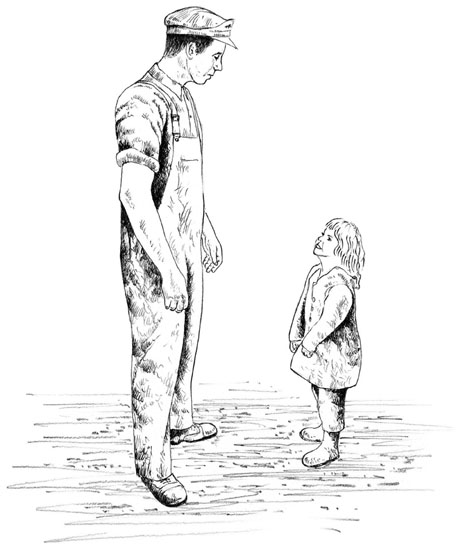
I was fortunate to work as a fireman on some notable steam locomotives in the final years of steam. As the steam era slid into history the work of the fireman as it was ceased. In 1965 steam was replaced by diesel and electricity as forms of traction by British Rail. The driver/fireman relationship on a steam locomotive, a relationship that had existed for years, was no longer there.
This is not a book about observing the workings of the footplate crew; it is a book about a fireman doing his job. A mere observer would see the discomforts of the train crew the heat, the dust, the knocks but he would also know that he, as an observer, did not actually experience them. I did.
The stories also offer an historical perspective on the job of being a fireman. In recording them I hope to go some way towards giving an account of the life and work of a footplate crew in the final years of steam. Perhaps, too, I am able to bring that to life through my stories.
I worked on the footplate from 1947 to 1960 and of course I am only writing about what happened to me. Some railwaymen gave their entire working life to service on the footplate and my contribution was small in comparison. I am sure that many footplate incidents have gone unrecorded. I hope that in relating these stories I will help fill what I consider to be a gap in the history of footplate work.
Next page
